Physical Address
304 North Cardinal St.
Dorchester Center, MA 02124
Physical Address
304 North Cardinal St.
Dorchester Center, MA 02124

Discover 20 stylish and durable mudroom flooring ideas that combine practicality with design flair. From waterproof options to budget-friendly choices, find the perfect foundation for your busy entryway.
Tired of dirt, mud, and outdoor grime constantly invading your home? Dreaming of a stylish yet practical space to corral the chaos at your entryway? Welcome to the mudroom – your home’s unsung hero, the transition zone between the wild outdoors and your pristine interiors.
But a mudroom is only as effective as its foundation. Choosing the right flooring is paramount to creating a space that’s not only functional and durable but also complements your home’s aesthetic. From battling muddy boots to withstanding spills and heavy foot traffic, mudroom flooring needs to be tough, easy to clean, and ideally, look fantastic while doing it.
When it comes to mudroom flooring that can truly stand up to anything life throws at it, porcelain tile emerges as a champion. Its reputation for being practically “indestructible” isn’t hyperbole – it’s rooted in its unique manufacturing process. Fired at extremely high temperatures, porcelain achieves remarkable durability thanks to its high density and incredibly low porosity. Scratches from garden tools? Water damage from damp outerwear? Stains from muddy paw prints? Porcelain shrugs them all off with ease.

Beyond mere resistance, porcelain’s non-porous surface prevents the growth of mold and mildew – crucial in a space frequently exposed to dampness. For ultimate durability, consider through-body porcelain where the color runs consistently throughout the entire tile, making chips and minor damages far less noticeable. Just be aware that porcelain can feel cold underfoot in colder climates (easily remedied with radiant floor heating) and can become slippery when wet (opt for textured or slip-resistant varieties).
Here’s where it gets interesting – porcelain tile is so durable that it’s often used in commercial settings with heavy foot traffic, making it perfect for even the busiest family mudrooms.
Ceramic tile stands as a testament to enduring design, offering a blend of timeless style and exceptional practicality that makes it a superb choice for bustling mudrooms. Its long-standing popularity stems from inherent characteristics perfectly suited to the demands of a high-traffic entryway – remarkable water resistance, exceptional durability, and refreshingly low maintenance requirements. A simple wipe down with a damp mop is usually all it takes to restore its pristine appearance.

The versatility of ceramic tile extends beyond functional benefits, offering a dazzling array of styles, colors, and patterns. Whether your vision leans towards classic solid colors like versatile grays and crisp whites, or you’re drawn to patterned tiles that artfully mimic natural stone or rich wood, ceramic provides endless design possibilities. Smaller tiles can create intricate patterns, while larger tiles offer a more contemporary look that promotes a sense of spaciousness.
What many people overlook is that ceramic tile has been used as a flooring material for thousands of years, dating back to ancient civilizations – a testament to its enduring practicality and beauty.
For those seeking to infuse their mudroom with an air of refined elegance, natural stone flooring – particularly slate and travertine – presents an exceptional choice. These materials transcend mere functionality, offering a high-end aesthetic that elevates the entire space while still delivering robust performance. Both boast excellent durability and water resistance, with slate providing natural slip resistance thanks to its textured surface.
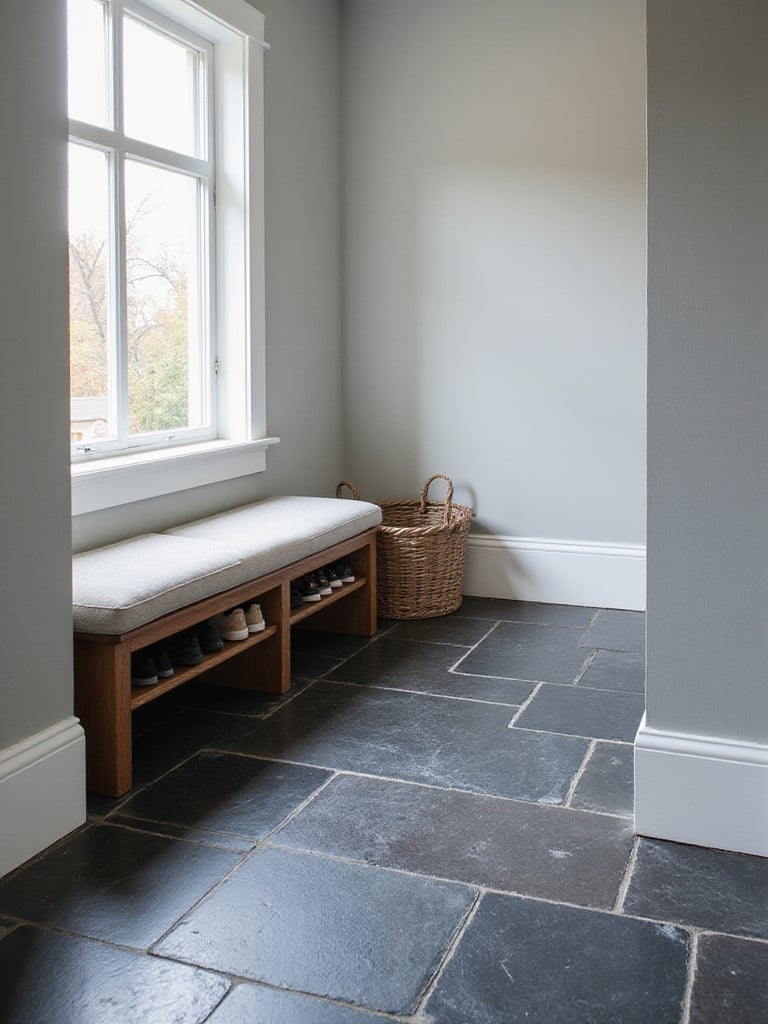
Despite their numerous advantages, natural stone options do come with considerations. They tend to be more expensive upfront compared to alternatives like ceramic tile or vinyl. Installation can be more complex, often necessitating professional expertise. Travertine, due to its porous nature, demands regular sealing every 1-2 years to effectively prevent staining and water damage. Slate, while generally robust, can occasionally flake or chip, although this is often considered part of its inherent rustic charm.
The breakthrough came when homeowners discovered that incorporating radiant floor heating beneath slate or travertine not only adds luxurious comfort during colder months but also helps dry wet footwear faster – a perfect marriage of luxury and practicality.
For homeowners who admire the warmth and classic appeal of hardwood flooring but seek a more practical solution for their mudroom, Luxury Vinyl Plank (LVP) emerges as an ideal alternative. LVP masterfully captures the aesthetic of real wood while offering a host of performance advantages perfectly suited to the demands of a busy entryway.

One of the key advantages of LVP is its exceptional water resistance, with many options being fully waterproof. Unlike hardwood, LVP won’t warp, stain, or harbor mold when exposed to damp conditions. It also boasts superior scratch resistance, holding up remarkably well against dirt, gravel, and pet claws. For mudrooms, prioritize LVP with a thick wear layer (ideally 20 mil or higher) and a waterproof core, either WPC (Wood Plastic Composite) or SPC (Stone Plastic Composite).
The surprising part is that today’s LVP is so realistic that it can be difficult to distinguish from real wood without close inspection – giving you the luxurious look of hardwood with none of the maintenance headaches.
For those drawn to clean lines, minimalist design, and a touch of industrial chic, concrete flooring presents a compelling and surprisingly versatile option for mudrooms. Beyond its inherently modern aesthetic, concrete offers exceptional durability, effortlessly handling the daily onslaught of muddy boots, wet umbrellas, and heavy foot traffic. Maintenance is remarkably straightforward – regular sweeping and occasional mopping are typically all that’s required.

While often perceived as purely utilitarian, concrete flooring offers surprising design versatility. It can be stained in a vast spectrum of colors, from subtle grays to vibrant blues. Various finishes – polished, honed, or textured – can achieve specific looks, while stamped concrete techniques can even mimic the appearance of tile or stone. For truly unique mudroom flooring, consider incorporating decorative aggregates or metal inlays into the concrete surface.
The heart of the matter is that concrete has been used as a building material for thousands of years, yet continues to evolve as one of the most adaptable and durable flooring options for modern homes – perfect for a hardworking mudroom.
For those prioritizing underfoot comfort, warmth, and environmental responsibility, cork flooring emerges as a truly unique and appealing option for mudrooms. Unlike harder flooring materials, cork’s natural elasticity provides a cushioned surface that is remarkably comfortable to walk and stand on. This inherent “give” reduces fatigue, while cork’s exceptional thermal properties mean it naturally stays warmer than materials like tile or stone in colder months.

Beyond its comfort benefits, cork flooring stands out as a highly eco-friendly choice. It’s derived from the bark of cork oak trees, a renewable resource harvested without harming the trees themselves. The bark regenerates naturally, allowing for repeated harvests approximately every nine years. Cork is also naturally antimicrobial, making it resistant to mold and mildew growth – a beneficial feature in potentially damp mudroom environments.
“Cork flooring creates a perfect balance between comfort and durability. It’s like walking on a cushioned surface that also happens to be environmentally friendly and naturally resistant to mold – ideal for a transition space like a mudroom.”
For households with active families, playful children, and furry companions, rubber flooring emerges as a remarkably practical choice for mudrooms. Its inherent properties make it exceptionally well-suited to withstand the daily hustle and bustle, spills, and potential mishaps that come with a busy entryway.

Rubber flooring excels in several key areas: – Superior slip resistance provides enhanced safety, crucial for families with young children – Exceptional impact resistance absorbs shocks and bumps – Waterproof nature readily handles moisture and spills – Sound-dampening qualities minimize noise from foot traffic – Comfortable, cushioned surface reduces fatigue
You might be wondering about style options. While often associated with a utilitarian black aesthetic, rubber flooring for mudrooms is available in a surprisingly diverse range of colors, patterns, and textures. Some options cleverly mimic the look of stone, wood, or even tile, expanding design possibilities far beyond what most homeowners expect.
Let me paint you a picture – imagine a mudroom where kids can run in from the rain without slipping, where dropped sports equipment doesn’t damage the floor, and where pet accidents clean up without leaving a trace. That’s the practical luxury of rubber flooring.
For those seeking to infuse their mudroom with a sense of warmth, character, and rustic charm, brick pavers offer a distinctive and durable flooring solution. Brick pavers bring a unique aesthetic appeal, adding a touch of old-world charm and timelessness to the space. Their inherent strength allows them to withstand heavy foot traffic, dirt, and moisture exposure with ease.
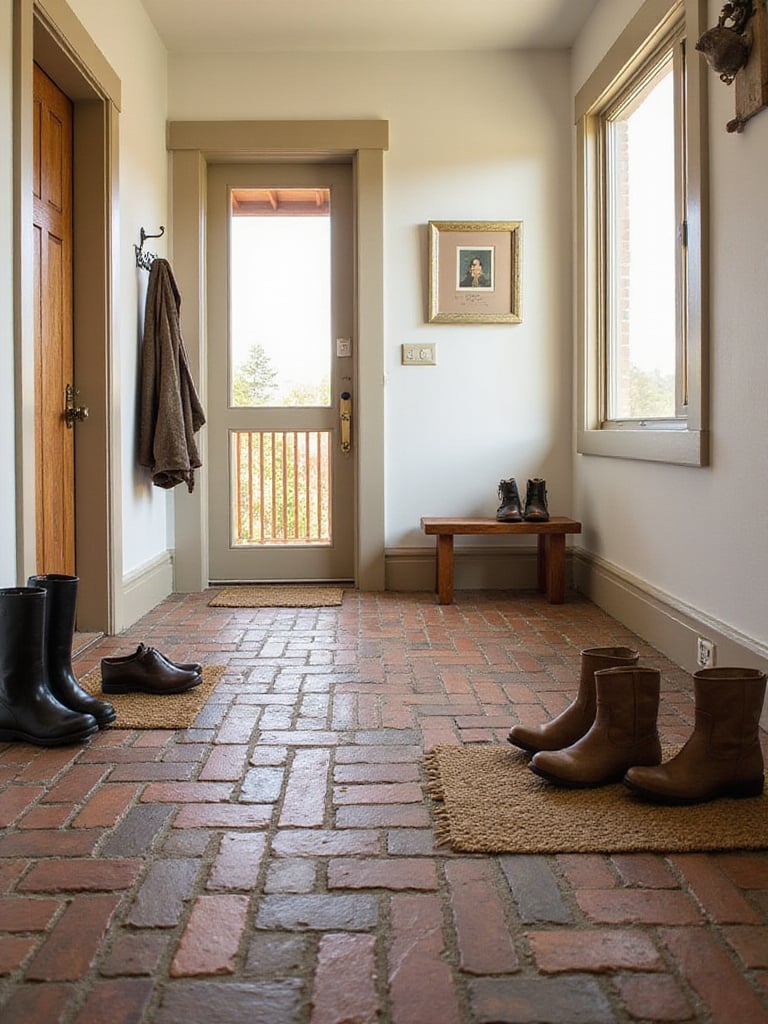
Before embarking on a brick paver installation, several key considerations are important. Subfloor preparation is paramount – a level and stable base is essential for proper brick installation. Sealing is crucial to protect from stains and moisture absorption. Choose a breathable sealant that allows moisture to escape from below, preventing potential damage. While brick is inherently durable, some maintenance is required to keep it looking its best, including occasional cleaning and periodic resealing.
It works something like this – the natural texture of brick provides excellent grip, minimizing the risk of slips and falls, while its classic and welcoming look effortlessly complements a variety of design styles, from farmhouse and traditional to even some modern interpretations. The result is a mudroom floor with character that can handle whatever your family throws at it.
For homeowners seeking ultimate peace of mind when it comes to waterproofing their mudroom flooring, sheet vinyl stands out as an exceptional and highly practical choice. Its primary strength lies in its seamless installation – sheet vinyl comes in large rolls, allowing it to be installed as a single, continuous surface across the entire room.
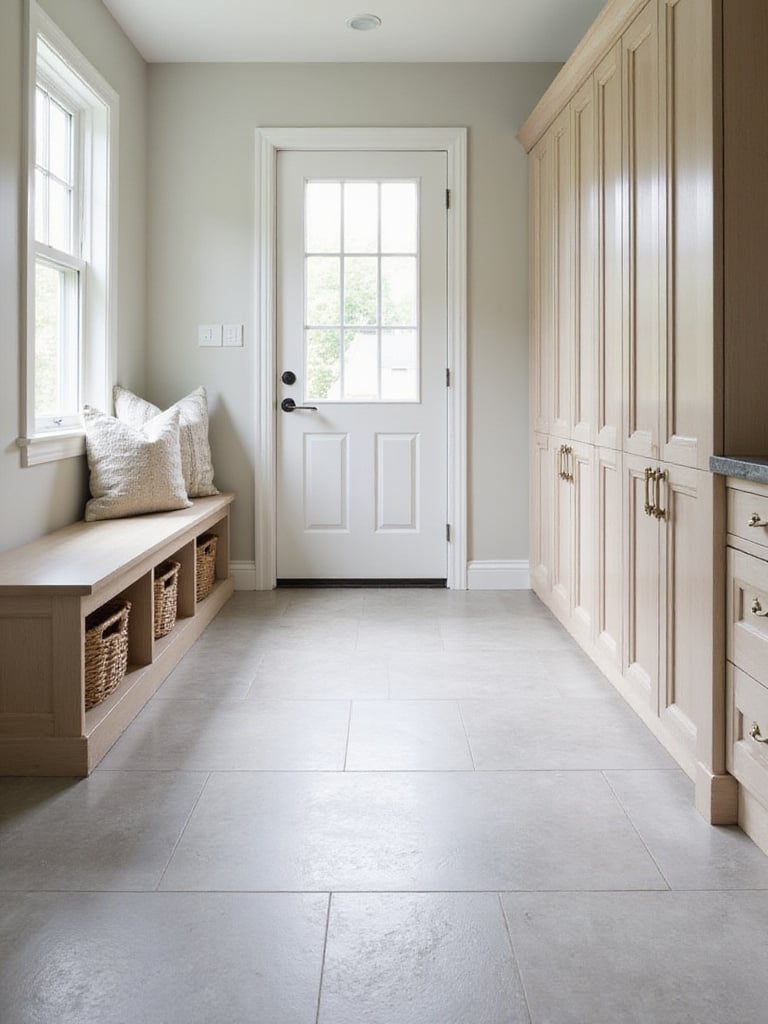
This seamless nature is the key to sheet vinyl’s exceptional waterproofing capabilities, preventing water from seeping through seams and reaching the subfloor. Beyond its superior waterproofing, sheet vinyl is durable, easy to clean, inherently stain-resistant, and often more budget-friendly compared to many other waterproof flooring options. When selecting sheet vinyl for your mudroom, consider thickness and wear layer (thicker is better for durability), texture for slip resistance, and a style that both harmonizes with your home’s aesthetic and effectively camouflages dirt.
The missing piece is understanding that sheet vinyl flooring was first introduced in the late 19th century and has evolved dramatically since then – today’s options offer sophisticated designs that can mimic natural stone, wood, or tile patterns while providing superior water protection for your mudroom.
For those seeking to infuse their mudroom with a vibrant dose of personality and visual interest, patterned tile offers an exciting avenue for creative expression. Patterned tiles transform a functional space into a design statement, adding flair and character to your entryway. With a vast array of patterns, colors, and styles available, you can create a truly unique and eye-catching mudroom floor that reflects your individual taste.

When selecting patterned tiles for a mudroom, durability and ease of maintenance remain paramount. Porcelain and ceramic tiles emerge as excellent choices, renowned for their robust nature and resistance to water and stains. Consider specific styles like encaustic-look tiles, geometric patterns, or Moroccan-inspired designs to bring visual drama to your space. For longevity, look for tiles with a PEI (Porcelain Enamel Institute) rating of 3 or higher, indicating suitability for moderate to heavy foot traffic.
Let me show you another perspective – patterned tile doesn’t just serve a decorative purpose. In smaller mudrooms, a bold pattern draws the eye and creates a distinct zone that separates the outdoors from your home’s interior, psychologically reinforcing the mudroom’s role as a transition space.
For those aiming to create a mudroom that feels both spacious and undeniably modern, large format tiles offer a transformative flooring solution. These generously sized tiles bring a sense of openness and contemporary elegance to even smaller mudroom spaces. By minimizing grout lines and creating a more continuous surface, they trick the eye into perceiving a larger space, making compact mudrooms feel more airy and open.
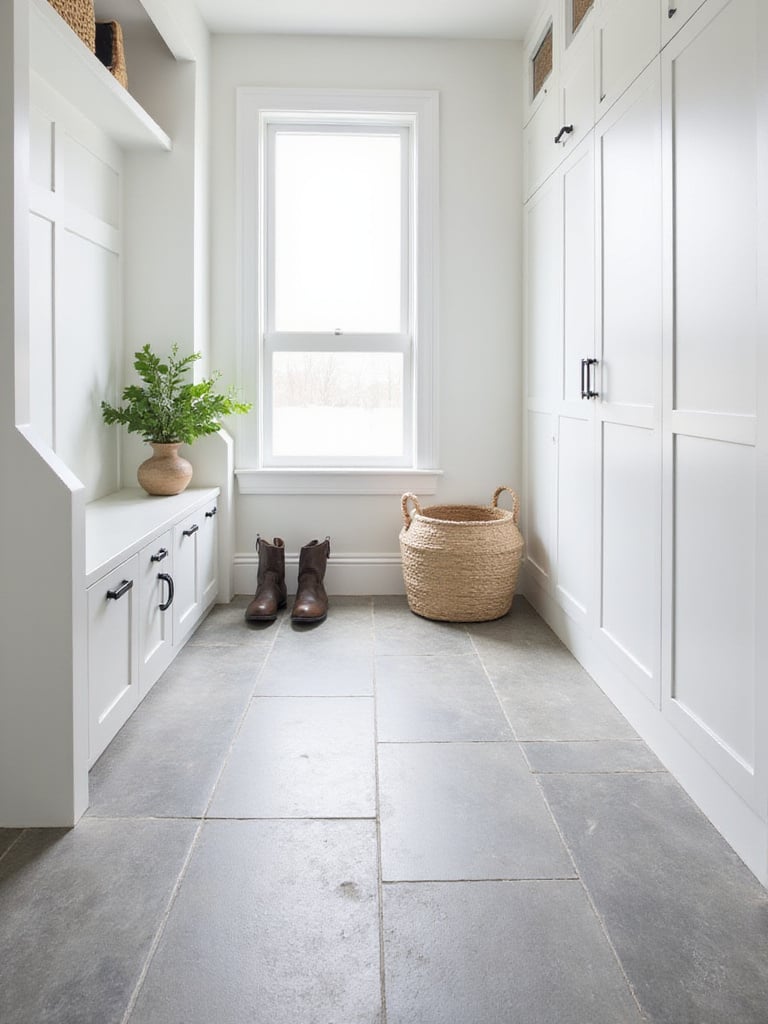
Fewer grout lines are not only visually appealing but also translate to less cleaning and maintenance. Grout, notoriously prone to trapping dirt and grime, is significantly reduced with large format tiles—a major advantage in a high-traffic, potentially messy area like a mudroom. For mudroom applications, porcelain is particularly recommended due to its superior durability, water resistance, and stain resistance. Professional installation is highly recommended due to the specialized tools and expertise required for handling these larger tiles.
The game-changer happened as I realized that large format tiles can make a small mudroom appear significantly larger than it actually is – an optical illusion that enhances both the aesthetic and psychological experience of the space.
While grout might seem like a minor detail in mudroom flooring, choosing dark grout can be a game-changer in maintaining a consistently clean appearance. Dark grout excels in mudrooms precisely because it effectively camouflages dirt, mud, and grime that inevitably accumulate in these high-traffic areas. Unlike light-colored grout, which can quickly become stained, dark grout maintains a cleaner visual impression for longer periods.
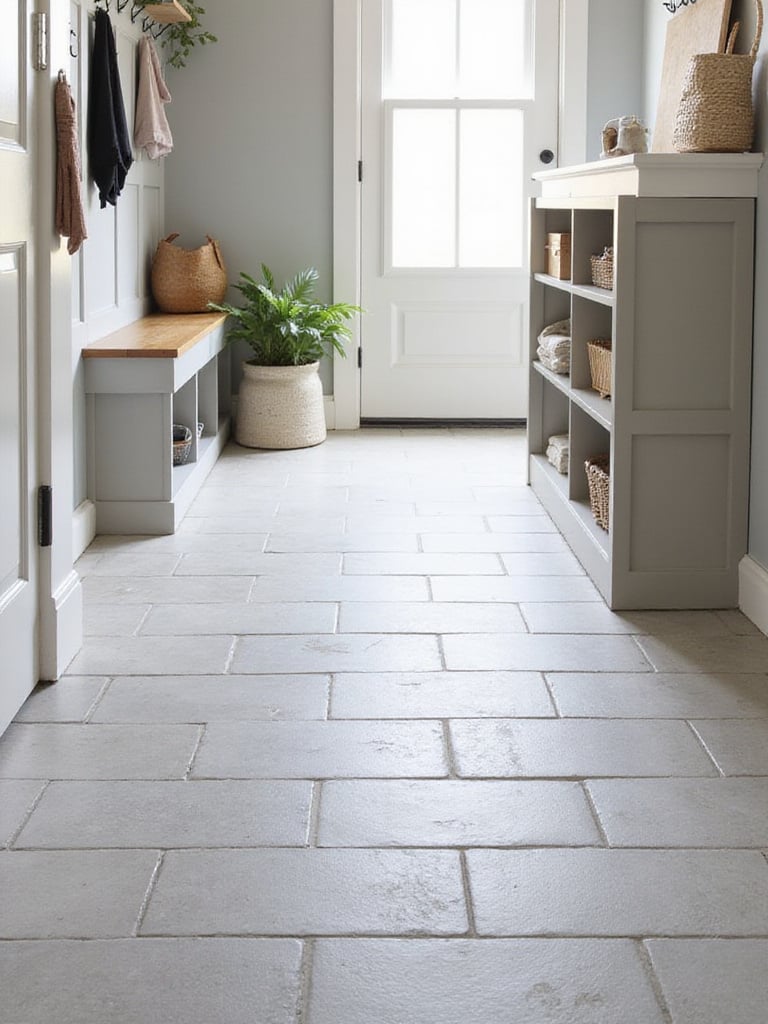
Popular dark grout colors for mudrooms include charcoal gray, dark brown, black, and even deep blues or greens. For a subtle contrast, consider a grout shade slightly darker than your tile. For a bolder, more modern look, opt for a contrasting black grout that emphasizes the tile pattern. While dark grout offers significant practical advantages, it’s important to know that it can sometimes make efflorescence (a white, powdery mineral deposit) more noticeable and may make it slightly harder to spot certain types of stains.
This changes everything, doesn’t it? Such a small detail as grout color can dramatically impact how often your mudroom looks clean, saving you countless hours of scrubbing and maintenance over the years.
Imagine stepping into your mudroom on a chilly morning and being greeted not by cold tile but by a luxuriously warm floor underfoot. Heated flooring options transform a mudroom from a purely functional space into a haven of comfort, particularly welcome during colder months. Beyond the obvious comfort benefit, heated floors offer practical advantages in a mudroom environment, aiding in drying wet shoes and boots more quickly and reducing the potential for mold and mildew growth.
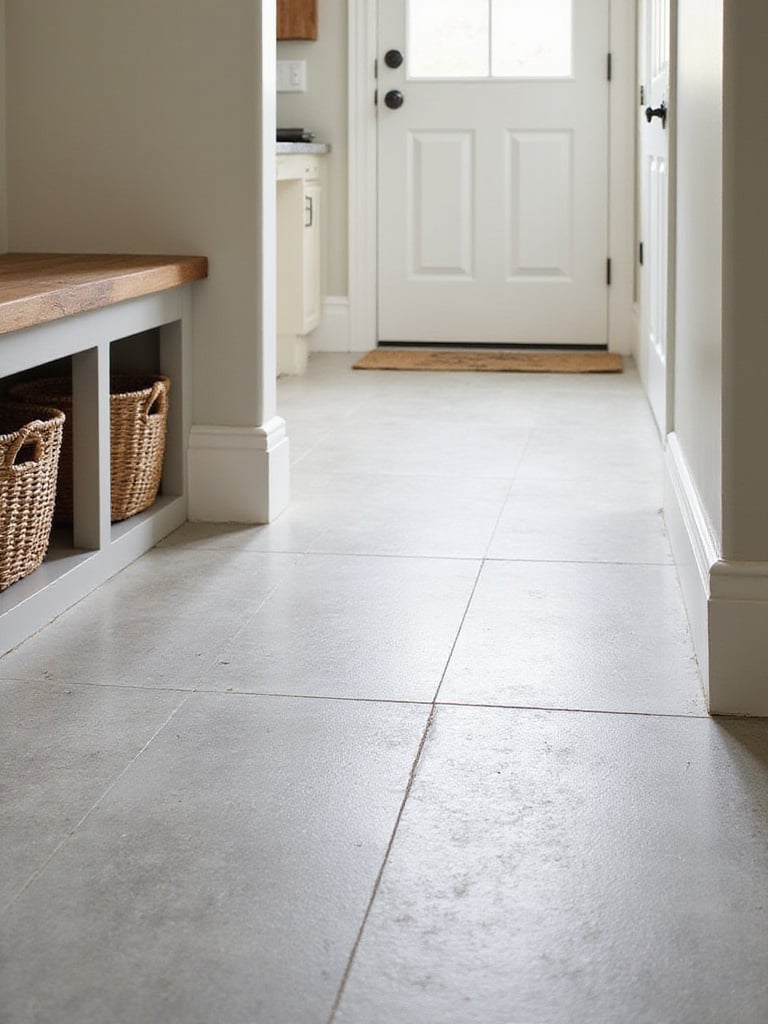
The two primary types of heated flooring suitable for mudrooms are electric radiant floor heating and hydronic radiant floor heating. For smaller areas like mudrooms, electric systems are generally easier and less expensive to install, making them a popular choice for retrofit projects. The choice of flooring material significantly impacts the effectiveness of radiant heat—tile, including ceramic, porcelain, and natural stone, stands out as the most efficient material due to its excellent thermal conductivity.
My experience went like this: after installing heated flooring in my mudroom, I discovered it wasn’t just a luxury—it became a practical necessity. Creating a designated ‘drying zone’ with heated flooring proved perfect for wet winter gear, eliminating that perpetually damp mudroom smell and extending the life of my footwear.
For homeowners prioritizing seamless surfaces, exceptional durability, and effortless cleaning in their mudroom, epoxy flooring presents a highly compelling option. Epoxy creates a smooth, monolithic surface that is not only visually appealing but also incredibly practical for a high-traffic, potentially messy entryway. The lack of grout lines or seams eliminates places for dirt and moisture to accumulate, making epoxy floors exceptionally easy to clean and maintain.
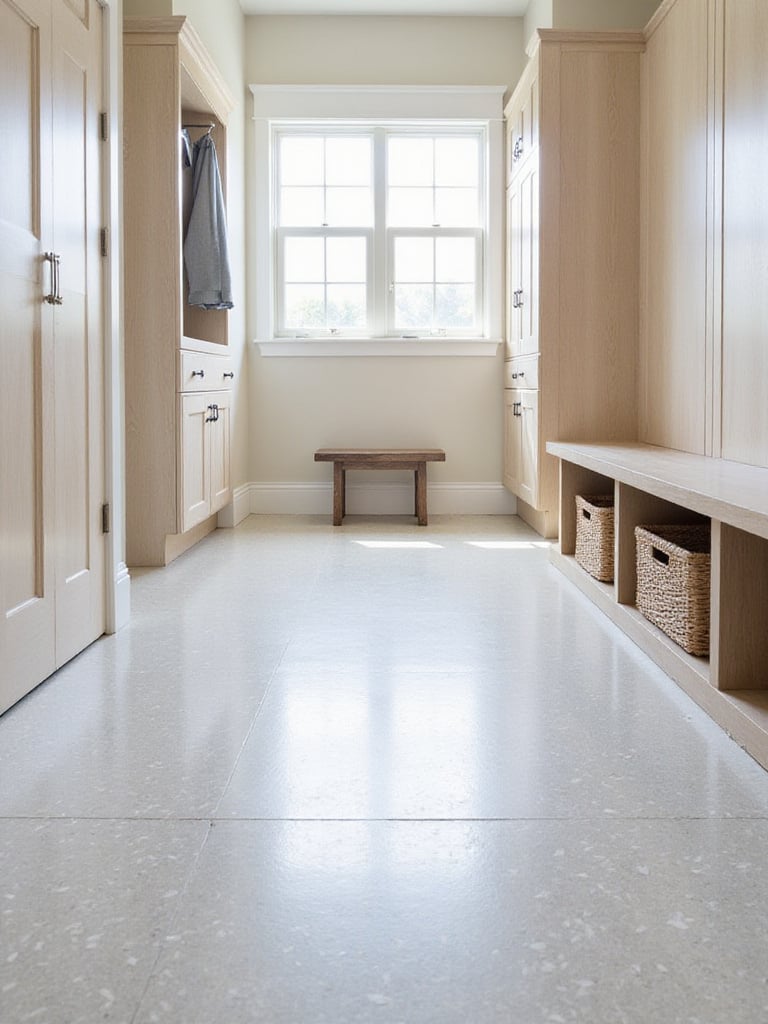
Several types of epoxy flooring are well-suited for mudroom applications: – Solid-color epoxy provides a clean, uniform look ideal for minimalist designs – Flake epoxy incorporates decorative chips, adding texture and visual interest – Metallic epoxy creates a shimmering, high-end aesthetic with pearlescent sheen – Self-leveling epoxy results in an exceptionally smooth surface – Epoxy coatings offer a cost-effective way to upgrade existing concrete floors
What complicates this choice is that while epoxy offers numerous advantages, installation requires meticulous surface preparation and can be time-consuming. Epoxy can also be slippery when wet—a factor to consider in a mudroom environment—though this can be mitigated by adding a non-slip additive during installation.
Regardless of the mudroom flooring material you choose, one step should never be overlooked: sealing. Sealing your mudroom flooring is not merely an optional extra; it’s a crucial investment in protecting your flooring, extending its lifespan, and simplifying cleaning. Sealant acts as an invisible shield, safeguarding your flooring from the daily onslaught of moisture, dirt, salt, and other debris tracked in from the outdoors.
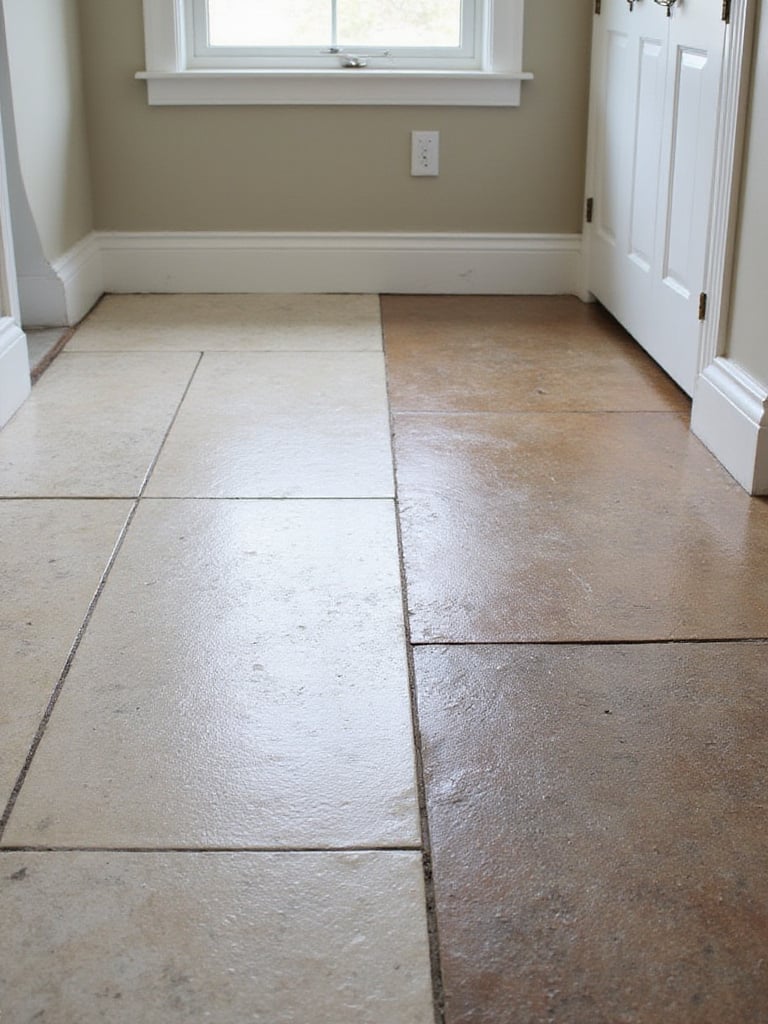
Unsealed floors are inherently porous, meaning they readily absorb liquids and contaminants. This absorption can lead to unsightly staining, water damage, mold growth, and accelerated wear and tear. The type of sealant you need depends entirely on your chosen flooring material—natural stone requires a penetrating sealant, tile and grout benefit from epoxy-based sealants, and concrete may need acrylic sealants or penetrating silane/siloxane sealers. A simple test to determine if resealing is necessary is to drop a few drops of water onto the floor surface; if the water beads up, the sealant is still effective, but if the water soaks in, it’s time to reseal.
The crucial element is that proper sealing can literally double the lifespan of your mudroom flooring—an investment of a few hours and relatively modest cost that pays dividends for years to come.
Safety is paramount in any home, and the mudroom, often exposed to moisture and outdoor elements, is an area where slip resistance is particularly crucial. Textured tiles provide a practical and stylish solution for enhancing grip and minimizing the risk of slips and falls in your mudroom entryway. Their textured surfaces offer a significant safety advantage, especially in households with children, elderly individuals, or anyone concerned about slippery floors.
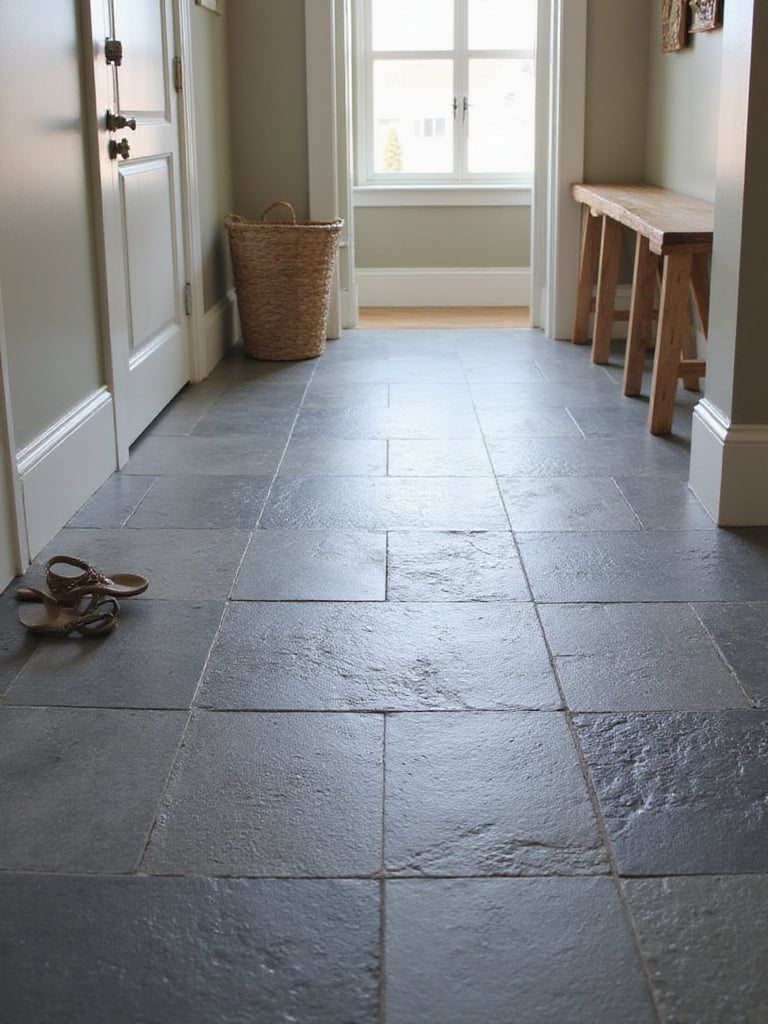
A variety of textures are commonly found in mudroom tiles, each offering a unique aesthetic and level of slip resistance: – Slate-like textures with natural variations in height and depth – Wood-look tiles with raised grain patterns – Embossed patterns featuring geometric or organic designs – “Orange peel” texture with a subtle, slightly dimpled surface – Aggregated stone or pebble textures for maximum grip
Things took an interesting turn when I discovered that the ‘Coefficient of Friction’ (COF) rating measures a tile’s slip resistance. For optimal safety in a mudroom, look for tiles with a COF of 0.6 or higher—a small technical detail that can make a significant difference in preventing household accidents.
When selecting mudroom flooring, it’s essential to consider not just style and durability, but also the climate in your region. Climate plays a significant role in the type of wear and tear your mudroom flooring will endure. Choosing flooring that is well-suited to your local climate is crucial for ensuring its longevity, minimizing maintenance needs, and maintaining its appearance over time.
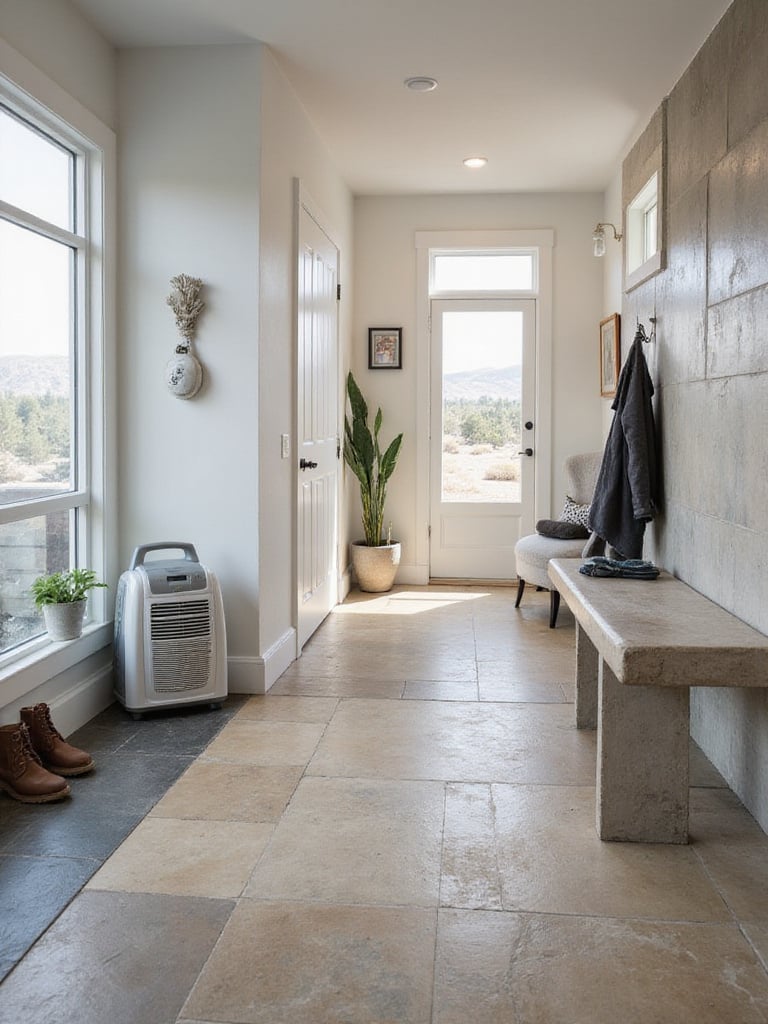
In cold, snowy climates, durable and highly water-resistant options like porcelain tile and properly sealed stone are paramount. Consider incorporating radiant heating beneath the flooring to enhance comfort and counteract the cold feel. For hot, humid climates, prioritize flooring materials resistant to mold and mildew growth, such as porcelain tile and vinyl flooring. In arid climates, look for materials that won’t dry out and crack, such as concrete, sealed tile, or engineered wood, and consider using rugs to trap dust and prevent scratching.
The tricky part is that salt used to melt ice can be highly corrosive to some flooring materials. Always clean salt residue promptly to prevent damage—a small but crucial maintenance step that can significantly extend the life of your mudroom flooring in colder regions.
For budget-conscious homeowners or those who enjoy a hands-on approach to home improvement, DIY flooring installation in a mudroom is entirely achievable with the right materials and preparation. Several flooring options are specifically designed for easy DIY installation, allowing you to transform your mudroom without the expense of professional labor.
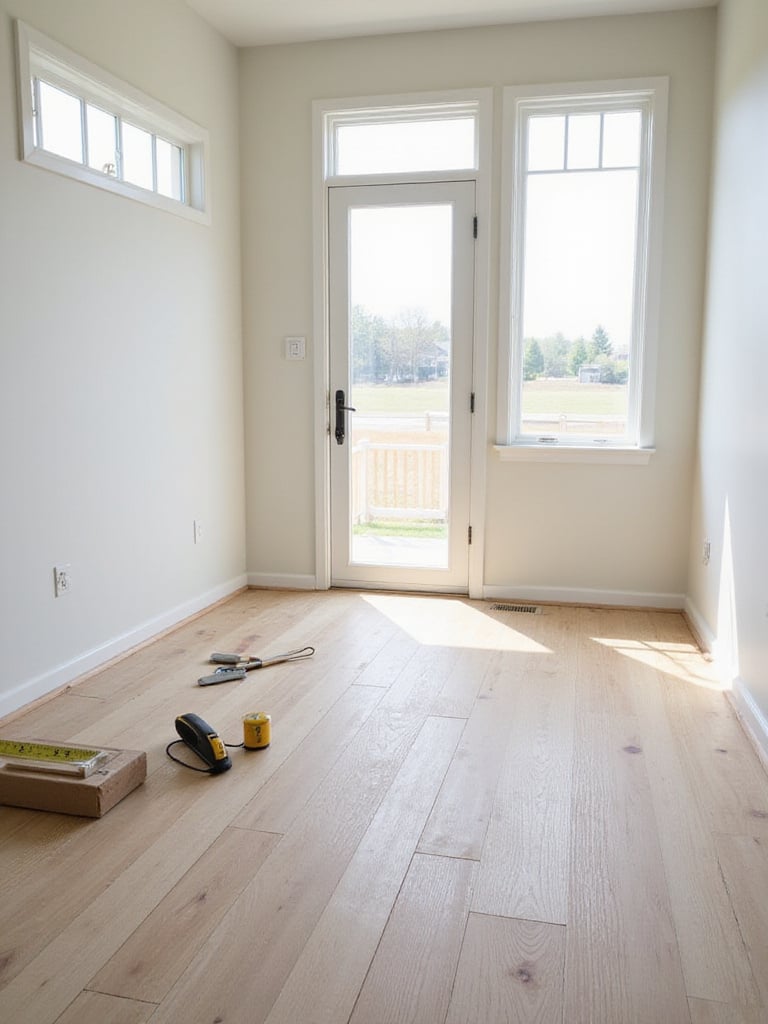
Several flooring types are particularly well-suited for DIY installation in mudrooms: – Luxury Vinyl Plank (LVP) and Luxury Vinyl Tile (LVT) with click-lock systems – Interlocking rubber tiles requiring no adhesive – Peel-and-stick vinyl tiles for an economical approach – Engineered wood flooring with click-lock systems – Porcelain tile for more experienced DIYers
My breakthrough came when I realized that proper preparation is absolutely essential for a successful DIY mudroom flooring project. Ensuring the subfloor is level, clean, dry, and structurally sound before beginning installation makes all the difference between a professional-looking result and a disappointing outcome that may need to be redone.
Creating a stylish and functional mudroom doesn’t necessitate a hefty budget. Numerous affordable flooring options offer both durability and aesthetic appeal, allowing you to achieve a beautiful mudroom without overspending. Smart material selections and strategic design choices can result in a mudroom that is both budget-friendly and visually appealing.
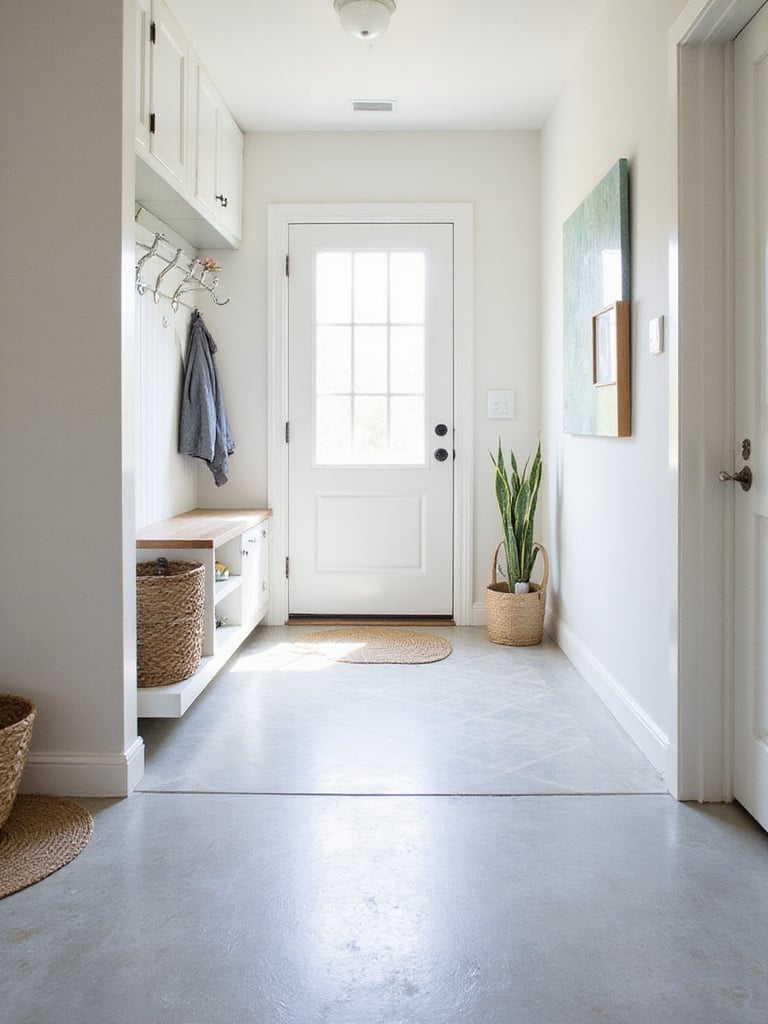
Several mudroom flooring options stand out as particularly durable and affordable: – Sheet vinyl offers excellent water resistance at a very low material cost – Luxury Vinyl Tile (LVT) mimics expensive materials at a fraction of the price – Ceramic tile in simpler designs and smaller tile sizes provides excellent value – Concrete flooring, when stained or sealed, creates a stylish and durable surface
Do you see how huge that is? You can create a designer-worthy mudroom on a modest budget by focusing on smart material choices rather than expensive ones. Strategic design elements like larger format tiles, interesting patterns with budget materials, or creative concrete staining techniques can elevate the look of economical mudroom flooring to appear far more expensive than it actually is.
Even the most durable and stylish mudroom flooring requires regular maintenance to keep it looking its best and performing optimally for years to come. Proper maintenance not only preserves the aesthetic appeal of your mudroom floor but also extends its lifespan and prevents long-term damage from dirt, moisture, and everyday wear and tear.
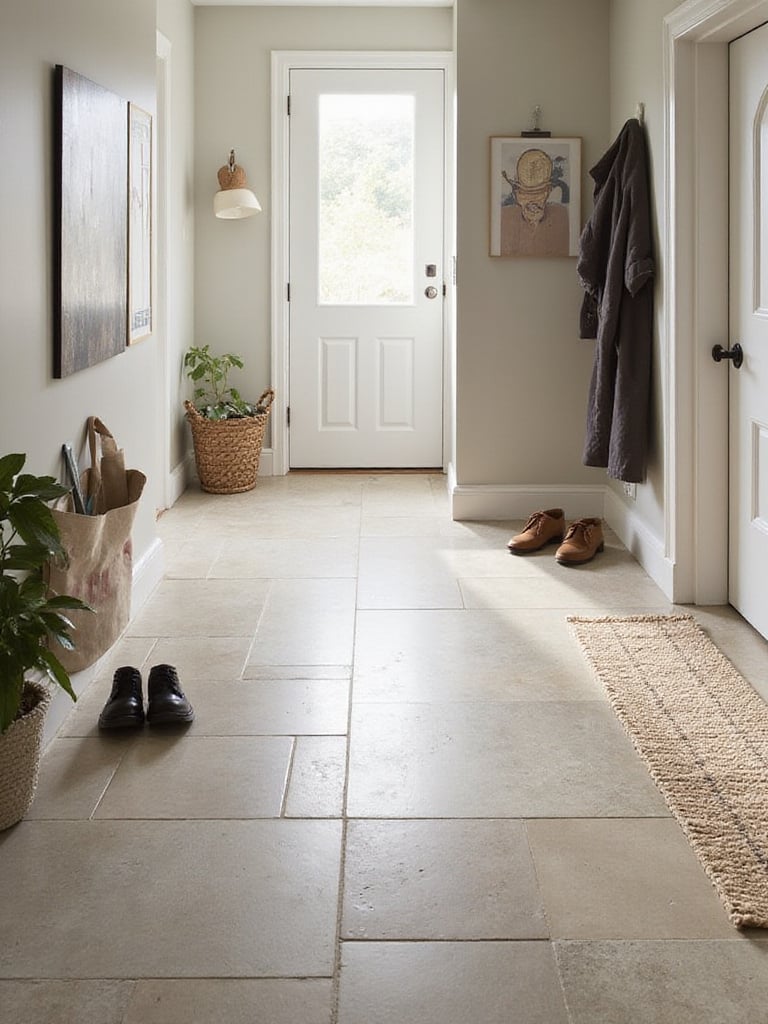
Understanding the most common types of contaminants found in mudrooms is crucial for selecting effective cleaning methods: – Soil and mud from shoes, boots, and pet paws – Water and snow that can lead to potential mildew growth – Corrosive salt from winter boots – Sand and gravel – Leaves and other organic matter – Pet hair and dander – General dust and dirt
The ripple effects are enormous when you establish a consistent cleaning routine. A quick daily sweep prevents debris buildup, while a weekly thorough cleaning maintains appearance and hygiene. For eco-conscious cleaning, simple solutions like white vinegar and water, baking soda for stubborn stains, or castile soap offer effective and environmentally friendly alternatives to harsh chemicals.
Choosing the right mudroom flooring is an investment in both the functionality and style of your home. By carefully considering durability, aesthetics, maintenance requirements, and your regional climate, you can create an entryway that welcomes you home in style, day after day.
From the rugged resilience of porcelain tile to the warm embrace of cork, and the budget-friendly practicality of vinyl to the luxurious elegance of natural stone, the options are as diverse as your individual needs and design preferences. Remember that proper sealing and maintenance will extend the life of whatever flooring you choose, ensuring your mudroom remains both beautiful and functional for years to come.
Your mudroom serves as the crucial transition between the outside world and your home sanctuary. With the right flooring choice, it can handle whatever your family (and Mother Nature) throws at it while still looking stylish enough to make a great first impression.